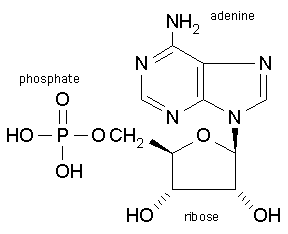 Here is
a picture of the nucleotide, adenosine monophosphate (AMP). At the top is the
double-ring of adenine, and below it is the pentagonal ribose. The phosphate
(PO4) is attached to the ribose to the left.
Here is
a picture of the nucleotide, adenosine monophosphate (AMP). At the top is the
double-ring of adenine, and below it is the pentagonal ribose. The phosphate
(PO4) is attached to the ribose to the left.| MadSci Network: Biochemistry |
First, let's define the term "nucleotide". You already know that DNA has these
four bases - Adenine, Cytosine, Guanine, and Thymine
(or Uracil in RNA) - and that the sequence of these bases forms the
information stored in the DNA; and you probably know that these bases are
attached to a "backbone" composed of sugar (ribose in RNA; deoxy-ribose in DNA)
and phosphates. Well, the actual building blocks of DNA and RNA are each
composed of a base attached to a single sugar attached to phosphates, so the
bases are rarely used or seen alone. Instead, they are found bound to ribose (or
deoxy-ribose) forming "nucleosides", e.g. adenine (a base) + ribose = adenosine
(a nucleoside); thymine + deoxyribose = thymidine. A nucleoside that is attached
to one or more phosphates is called a nucleotide.
 Here is
a picture of the nucleotide, adenosine monophosphate (AMP). At the top is the
double-ring of adenine, and below it is the pentagonal ribose. The phosphate
(PO4) is attached to the ribose to the left.
Here is
a picture of the nucleotide, adenosine monophosphate (AMP). At the top is the
double-ring of adenine, and below it is the pentagonal ribose. The phosphate
(PO4) is attached to the ribose to the left.
Now, let's completely switch directions for the next set of definitions - macromolecules. As the name suggests, macro-molecules are very large molecules that are composed of much smaller subunits, like DNA, proteins, starch, etc. When discussing macromolecules, we commonly use the suffix "-mer" to refer to the subunits in general. We then use prefixes to denote about how many subunits are present in a molecule: e.g. a monomer is a single subunit; a dimer is two atttached subunits; a trimer is made of three subunits; an oligomer is made of several (10 - 50) subunits; and a polymer has many, many subunits (over 50). So, a dimer of DNA or RNA would be a molecule containing two attached subunits, which we have already defined as nucleotides; therefore a "dinucleotide" is a single piece of DNA or RNA that is two nucleotides long.
The example you give of a thymidine dinucleotide would be two thymidine nucleotides attached by a phosphate bridge - in this case, the 5'-phophate of one thymidine bonds to the 3'-hydroxyl group of the other thymidine, just as the bonding occurs in complete DNA and RNA molecules. This kind of dinucleotide is often abbreviated as NpN, where N is any nucleotide and "p" indicates the phosphate bridge; thus, thymidine dinucleotide would be abbreviated, TpT. This abbreviation is important to distinguish dinucleotides from basepairs in double- stranded DNA, where CG is an interacting pair of bases on opposite strands, but CpG is a dinucleotide within one strand (for longer stretches, like trimers and above, the p's are dropped). There is another group of dinucleotides that are essential for energy transfer, which bind phosphate-to-phosphate, creating a 5'- 5' diphosphate bridge. The most common of these are NAD+, which is niacin-adenosine dinucleotide, and FAD, which is riboflavin-adenosine dinucleotide (it is interesting that some of the most important co-enzymes are B-complex vitamins bound to adenosine). To sum up: a dinucleotide is a single molecule composed of two, linked nucleotides - the building blocks of DNA and RNA.
Try the links in the MadSci Library for more information on Biochemistry.